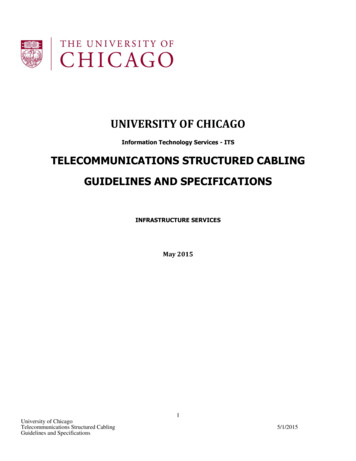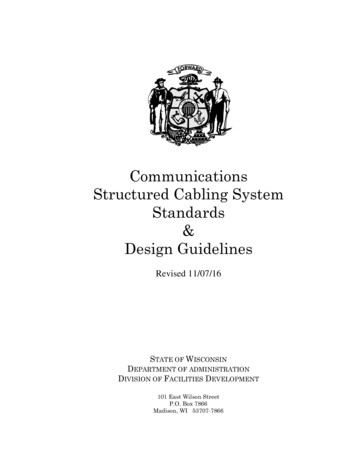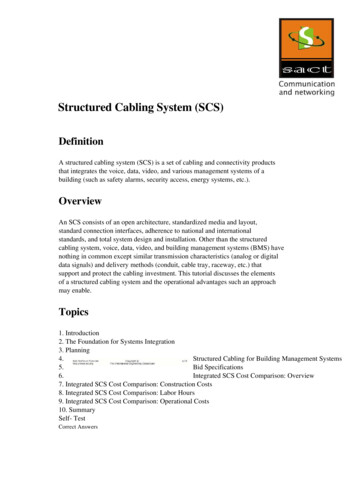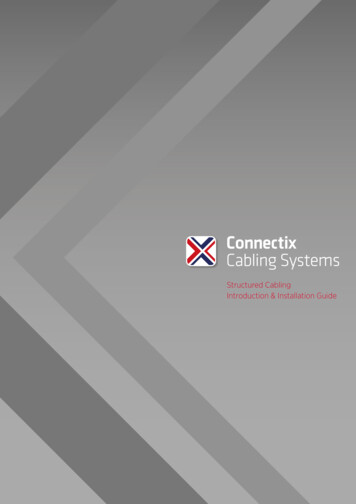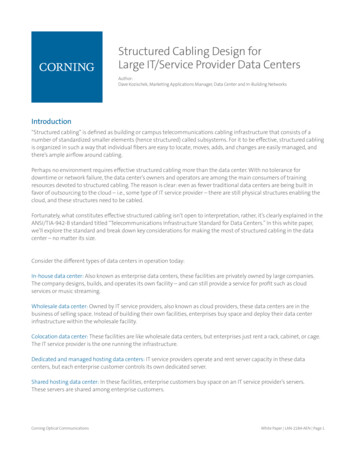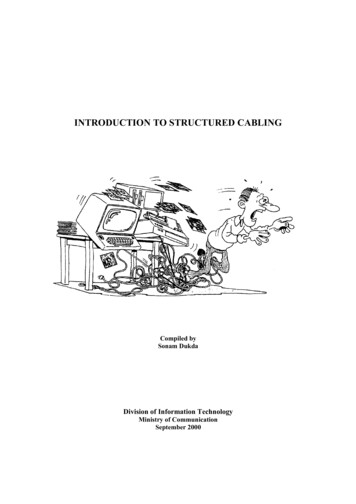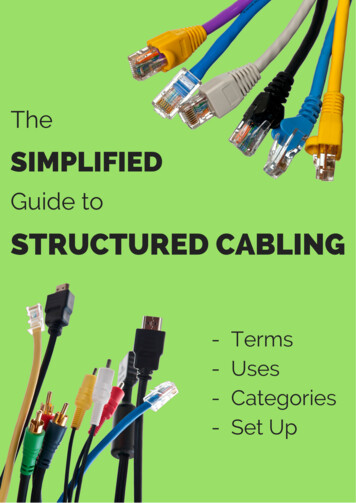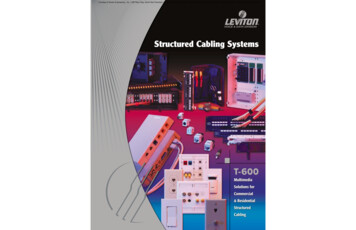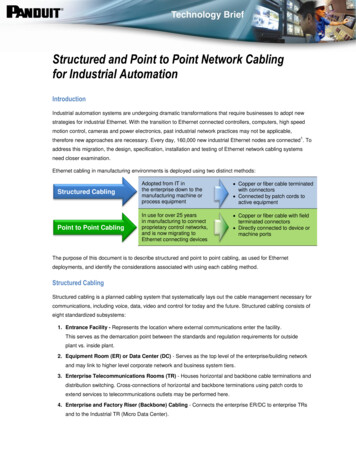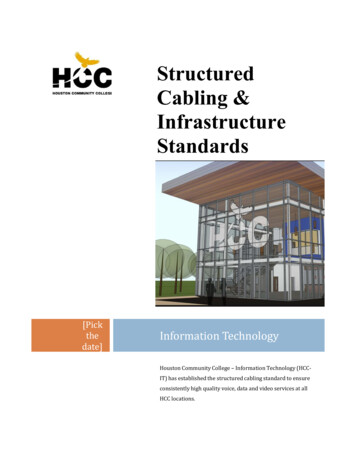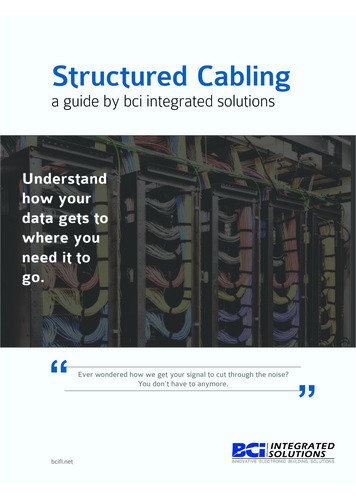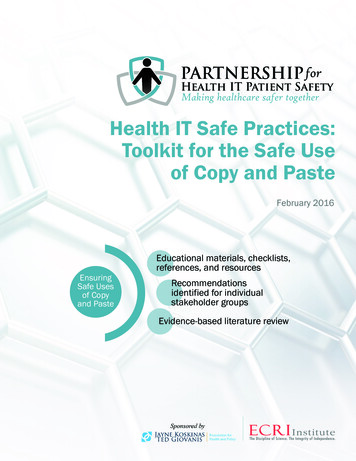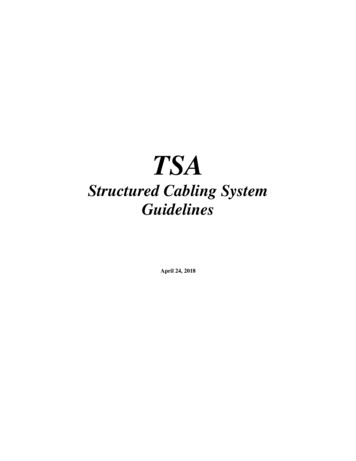
Transcription
TSAStructured Cabling SystemGuidelinesApril 24, 2018
TSA Structured Cabling System Guidelines Issue Date: 04/24/181.INTRODUCTION . 11.1Scope . 11.2Structured Cabling Systems . 11.3Telecommunications Wiring System Subsystems . 11.4Site Preparation Guidelines . 21.4.1 General Information. 21.4.2 Specifications. 22.EQUIPMENT SUBSYSTEM . 22.1Definition . 22.2General Information. 32.2.1 Equipment Specifications . 32.2.2 UTP Patch Cords. . 43. HORIZONTAL SUBSYSTEM . 43.1Definition . 43.2General Information. 44. MAIN DISTRIBUTION FRAME (MDF) and INTERMEDIATE DISTRIBUTION FRAME (IDF) EQUIPMENTSUBSYSTEM AND TELECOMMUNICATIONS CLOSETS . 44.1Definition . 44.2General Information. 54.3Specifications. 64.3.2 Floor Loading . 64.3.3 Provisioning . 65. IN-BUILDING BACKBONE SUBSYSTEM . 75.1Definition . 75.2General Information. 75.3.1 Site Selection . 75.3.2 Floor Loading . 75.3.3 Water Infiltration . 75.3.4 Heating, Venting and Air Conditioning (HVAC) . 85.3.5Electromagnetic Interference . 85.3.6Vibration . 85.3.7 Size . 85.3.8 Provisioning . 86.FUTURE INFORMATION . 97. CAMPUS BACKBONE SUBSYSTEM . 97.1Definition . 98. INSTALLATION AND ONGOING MAINTENANCE. 98.1Physical Routing . 98.1.1 Separation from Sources of Electromagnetic Interference (EMI) . 108.1.2 UTP Splices and Bridge Taps . 108.1.3 UTP Cable Bends . 108.1.4 Patch Cords . 108.2Conduit . 118.2.1 General . 118.2.2 Types of Conduit . 118.2.3 Use of Conduit . 118.2.4 Minimum Requirements . 118.2.5 Bends . 118.2.6 Fish-tape or Pull-cord . 118.2.7 Conduit Runs . 118.2.8 Conduit Termination . 128.3Physical Media Specifications . 128.3.1 Technical Reference . 128.3.2 Length . 128.3.3 Construction. 12i
TSA Structured Cabling System Guidelines Issue Date: 04/24/188.3.4 Twisted Pairs . 128.3.5 Cable Diameter . 138.3.6 Breaking Strength . 138.3.7 Bending Radius. 138.3.8 UTP Polarization . 138.4.1 Technical Reference . 138.4.2 DC Resistance. 138.4.3 DC Resistance Unbalance . 148.4.4 Mutual Capacitance . 148.4.5 Capacitance Unbalance: Pair to Ground . 148.4.6 Characteristic Impedance and Structural Return Loss (SRL) . 148.5.1 Technical Reference . 148.5.2 Overall Construction . 148.5.3 RJ-45 Construction . 148.6.1 Technical References . 148.6.2 Construction. 158.6.3 Quantity . 158.7.1 Technical Reference . 158.7.2 Transmission Characteristics . 158.8.1 Technical Reference . 158.8.2 Construction . 158.9.1 Technical Reference . 168.9.2 Attenuation . 169.ACCEPTANCE TESTING . 169.1Definition . 169.2General . 169.3.1 Visual Inspection . 169.3.2 Certification Requirements . 1710.LABELING, CABLE STADANDARDS AND CABLE MANAGEMENT . 1710.1Introduction . 1711.FIRESTOPPING . 2211.1Definition . 2211.2General information . 2211.3Requirements . 2211.4Specifications. 2211.5Approved Material Types . 2311.6Selection criteria . 2312TELECOMMUNIATIONS BONDING AND GROUNDING REQUIREMENTS . 2313.TSA CABINET SPECIFICATIONS . 2513.1Cabinet Electrical Specifications . 2513.2 Cabinet Size Specifications – Open Racks . 2513.3Cable Management for Open Racks . 2613.4Cabinet Sizes Specifications – Wall-Mount Cabinets . 2713.5Cabinet Sizes Specifications - Closed Racks . 2713.6Cabinet Air Conditioning Requirements . 2814.GLOSSARY . 2915.ACRONYMS . 30ii
TSA Structured Cabling System Guidelines Issue Date: 04/24/18This page intentionally blank.iii
TSA Structured Cabling System Guidelines Issue Date: 04/24/181.INTRODUCTIONThis document provides direction for a telecommunications wiring system for TSA spaces or buildings tosupport TSA’s mission and operations. Its purpose is to enable the planning and installation of buildingwiring with minimal advance knowledge of the telecommunications products used.Building wiring represents a significant investment. A variety of wiring plans and media exist in buildingstoday, resulting in an increase in labor costs for move, add and change (MAC) activities. Also, selectivere-wiring is occurring in some locations where the existing media does not provide sufficient bandwidthtransport capabilities.These guidelines are to apply to future installations and renovations of buildings and work areas.The content of this document follows EIA/TIA guidelines. It represents a subset of the appropriateEIA/TIA standards refined to meet specific TSA requirements. All cabling standards contained herein areinstaller independent.1.1ScopeThis content of this document defines guidelines for structured telecommunications wiring within TSAfacilities or buildings. This includes all components from work area connections to local inter-buildingfacilities. Deviation is discouraged, although, designers will review and document if necessary.1.2Structured Cabling SystemsThe specifications contained in this document originate from the recommended use of structured cablingsystems for all communications wiring requirements. These systems are composed of cabling segmentsthat generally correspond to the vertical and horizontal dimensions of buildings and campuses. Byinterconnecting these segments to one another in prescribed ways, complete end-to-end connections existto support the physical wiring needs of various systems. Standards refer to each such segment of cablingas a subsystem.When at all possible, install structured cabling systems as fully as possible in their plant andadministrative buildings. This may lead to a certain degree of pre-wiring at workstations where presentequipment needs are minimal or even nonexistent. Pre-wiring
Apr 24, 2018 · TSA Structured Cabling System Guidelines Issue Date: 04/24/18 3 2.2 General Information 2.2.1 Equipment Specifications Each of the four-pair UTP Category 5E/6 cables will terminate in the MDF, or IDF, on the same numbered port on the appropriate File Size: 712KB
